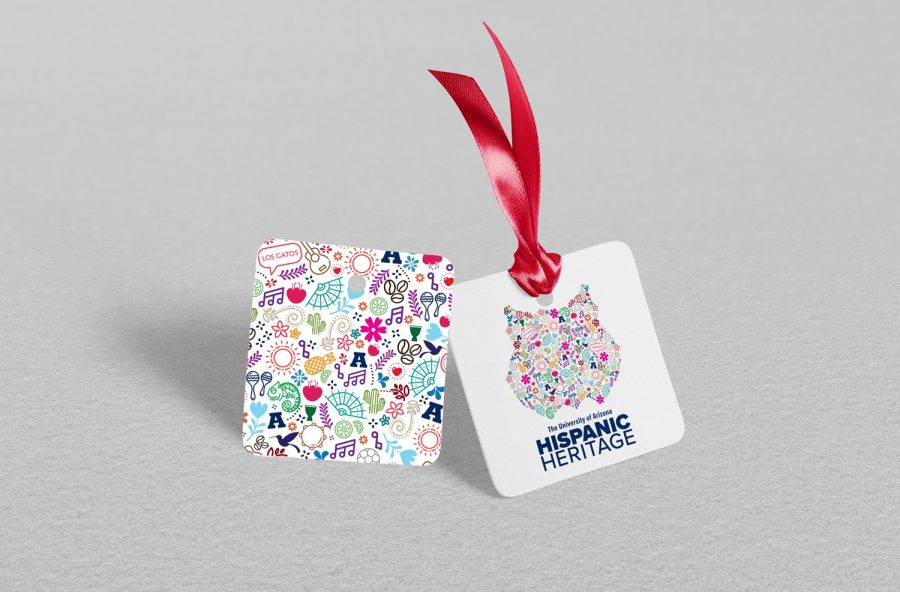At the start of National Hispanic Heritage Month, the University of Arizona released the new design of a cultural emblem representing the Hispanic and Latinx communities on campus and in Tucson. The design is officially part of the UA’s marketing and communications department.
In the summer of 2019, there was a spurt of interest inside marketing and brand management in creating new logos for Hispanic Heritage Month.
RELATED: Election 2020: A breakdown of District 3 candidates
Thomas Harris, the UA’s assistant athletics director, explained that while he had always been involved in heritage month celebrations for student athletes, when the marketing group fell apart, he requested to take charge of it. His vision of celebrating all cultural months then expanded the project to all four cultural centers on campus.
Focus groups started up for each of the four logos, made up largely of students, cultural center staff, alumni associations and community council. Since last fall, Harris has been organizing the design process, and meetings have been ongoing since February of this year up till just a few weeks ago.
Jessica Estrella, logo artist and designer for the Hispanic Heritage emblem and art director of UA marketing, started brainstorming before winter break of the 2019-2020 academic year. Despite the disruption of the pandemic, the project quickly kicked back up in May. The final emblem is the outline of the Wildcat face filled with several small icons, each that underwent a rigorous vetting process before making it into the official logo.
Part of what made the process so lengthy, Estrella said, was that under the umbrella of Hispanic and Latinx culture, there are a large variety of differences between each country.
“How do we connect all the Spanish-speaking countries through different icons?” Estrella said. “Even though we are all Hispanic, we don’t necessarily have the same exact culture … we tried to extract everything that was common knowledge to everybody, and that’s what goes into logos. Every icon is specific to what unified us as a whole.”
Estrella also explained how she came to her design.
“Flamenco dancers — they’re great [as one of the icons to include], but they’re very specific to Spain, and if that was the case, we would then need tango dancers, which are from Argentina … You can’t have everything,” Estrella said. “The unifying link was, we love music, we love dancing. That’s how we came to a universal way of saying it, while still going into specific things that really represent each community.”
Dr. Marla Franco, assistant vice provost, said one of the largest considerations was ensuring that this was created by the whole community. Estrella said that while perhaps it was her hand that drew it, it was the community of people from a variety of backgrounds and perspectives that remained the backbone of creating the emblem.
“How do we make sure that we’re intending to be inclusive and affirming?” Franco asked. “I think if you’re not intentional about how you do that work, you can very easily and unintentionally do the very opposite. The only way to ensure it was community driven was taking the time to seek people’s input.”
Alongside this month’s release comes a variety of apparel with the emblem emblazoned on it as well as other digital items for students to purchase or download. The final results of this project was placing the emblem on a variety of clothing items, even on toddler’s clothing, to maintain the theme of family in Hispanic culture. There are phone wallpapers available as well as Spotify playlists.
According to Estrella, 100% of the royalty fees goes to the Adalberto and Ana Guerrero Student Center, and about 10% of the UA Bookstore’s proceeds will be donated to the center as well.
RELATED: Struggling to be seen: UA community reactions to recent Obergefell v. Hodges statement
The intention is that these emblems can and will be used year-round. Rather than merely producing marketing material, the Hispanic Heritage campaign is meant to truly give back to the Hispanic community. Rather than simply talking about Hispanic culture, the campaign aims for everyone to experience and live it.
“The counter narrative to [celebrating heritage months] is, ‘I want you to celebrate and validate my culture throughout the entire year,'” Franco said. “How do we make sure that we actually use [cultural emblems] all throughout the year so as not to reserve the celebration and our heritages to just one month?”
Franco spoke earnestly about what she hopes to see in the future — that the emblem is just one step in a series of next steps in making the UA community as welcoming as possible and ensure equitable treatment of every community on campus.
“It’s not just an emblem,” Franco said. “The most important part of this to me, to be honest, is all the work, and the diligence, and the attention to detail, and the partnership that took place throughout the duration of this process that then led to the production of the emblem.”
She hopes the development of the new logo is also coupled with inclusive engagement throughout campus.
“I hope that it’s coupled with the presence of faculty and staff that look like our students,” Franco said. “I hope that it’s coupled with sensitive and affirming campus climates throughout our campus … I hope that this is one of many things that makes the University of Arizona not only feel like but also be committed in practice to inclusion and the value of diversity.”
Three other emblems for Native American History Month, Black History Month, as well as Asian American and Pacific Islander History Month will be released on Nov. 1, Feb. 1 and May 1 respectively.
Follow Annie Gao on Twitter








